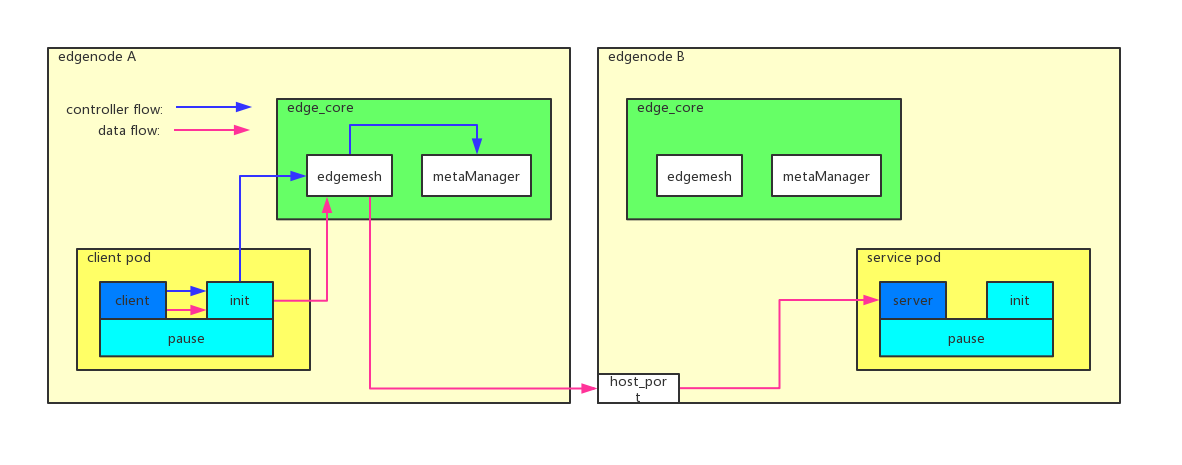In case network issue between cloud and edge side, we integrate EdgeMesh to support DNS visit at any time.
Currently we only support HTTP1.x, more protocols like HTTPS and gRPC coming later.
EdgeMesh is enabled as default.
Limitation
- Ensure network interface “docker0” exists, which means that EdgeMesh only works for Docker CRI.
Environment Check
Before run examples, please check environment first.
DNS Order
Modify /etc/nsswitch.conf, make sure dns is first order, like below:
$ grep hosts /etc/nsswitch.conf
hosts: dns file mdns4_minimal [NOTFOUND=return]
IP Forward Setting
Enable ip forward:
$ sudo echo "net.ipv4.ip_forward = 1" >> /etc/sysctl.conf
$ sudo sysctl -p
Then check it:
$ sudo sysctl -p | grep ip_forward
net.ipv4.ip_forward = 1
Usage
Assume we have two edge nodes in ready state, we call them edge node “a” and “b”:
$ kubectl get nodes
NAME STATUS ROLES AGE VERSION
edge-node-a Ready edge 25m v1.15.3-kubeedge-v1.1.0-beta.0.358+0b7ac7172442b5-dirty
edge-node-b Ready edge 25m v1.15.3-kubeedge-v1.1.0-beta.0.358+0b7ac7172442b5-dirty
master NotReady master 8d v1.15.0
Deploy a sample pod from Cloud Side:
$ kubectl apply -f https://raw.githubusercontent.com/kubeedge/kubeedge/master/build/deployment.yaml
deployment.apps/nginx-deployment created
Check the pod is up and is running state, as we could see the pod is running on edge node b:
$ kubectl get pods -o wide
NAME READY STATUS RESTARTS AGE IP NODE NOMINATED NODE READINESS GATES
nginx-deployment-54bf9847f8-sxk94 1/1 Running 0 14m 172.17.0.2 edge-node-b <none> <none>
Check it works:
$ curl 172.17.0.2
<!DOCTYPE html>
<html>
<head>
<title>Welcome to nginx!</title>
<style>
body {
width: 35em;
margin: 0 auto;
font-family: Tahoma, Verdana, Arial, sans-serif;
}
</style>
</head>
<body>
<h1>Welcome to nginx!</h1>
<p>If you see this page, the nginx web server is successfully installed and
working. Further configuration is required.</p>
<p>For online documentation and support please refer to
<a href="https://nginx.org/">nginx.org</a>.<br/>
Commercial support is available at
<a href="https://nginx.com/">nginx.com</a>.</p>
<p><em>Thank you for using nginx.</em></p>
</body>
</html>
172.17.0.2 is the IP of deployment and the output may be different since the version of nginx image.
Then create a service for it:
$ cat <<EOF | kubectl apply -f -
apiVersion: v1
kind: Service
metadata:
name: nginx-svc
namespace: default
spec:
clusterIP: None
selector:
app: nginx
ports:
- name: http-0
port: 12345
protocol: TCP
targetPort: 80
EOF
- For L4/L7 proxy, specify what protocol a port would use by the port’s “name”. First HTTP port should be named “http-0” and the second one should be called “http-1”, etc.
Check the service and endpoints:
$ kubectl get service
NAME TYPE CLUSTER-IP EXTERNAL-IP PORT(S) AGE
nginx-svc ClusterIP None <none> 12345/TCP 77m
$ kubectl get endpoints
NAME ENDPOINTS AGE
nginx-svc 172.17.0.2:80 81m
To request a server, use url like this: <service_name>.<service_namespace>.svc.<cluster>.<local>:<port>
In our case, from edge node a or b, run following command:
$ curl http://nginx-svc.default.svc.cluster.local:12345
<!DOCTYPE html>
<html>
<head>
<title>Welcome to nginx!</title>
<style>
body {
width: 35em;
margin: 0 auto;
font-family: Tahoma, Verdana, Arial, sans-serif;
}
</style>
</head>
<body>
<h1>Welcome to nginx!</h1>
<p>If you see this page, the nginx web server is successfully installed and
working. Further configuration is required.</p>
<p>For online documentation and support please refer to
<a href="https://nginx.org/">nginx.org</a>.<br/>
Commercial support is available at
<a href="https://nginx.com/">nginx.com</a>.</p>
<p><em>Thank you for using nginx.</em></p>
</body>
</html>
- EdgeMesh supports both Host Networking and Container Networking
- If you ever used EdgeMesh of old version, check your iptables rules. It might affect your test result.
Sample

Model

- a headless service (a service with selector but ClusterIP is None)
- one or more pods’ labels match the headless service’s selector
- to request a server, use:
<service_name>.<service_namespace>.svc.<cluster>:<port>:- get the service’s name and namespace from domain name
- query all the backend pods from MetaManager by service’s namespace and name
- LoadBalance returns the real backend containers’ hostIP and hostPort
Flow

- client requests to server by server’s domain name
- DNS being hijacked to EdgeMesh by iptables rules, then a fake ip returned
- request hijacked to EdgeMesh by iptables rules
- EdgeMesh resolves request, gets domain name, protocol, request and so on
- EdgeMesh load balances:
- get the service’s name and namespace from the domain name
- query backend pods of the service from MetaManager
- choose a backend based on strategy
- EdgeMesh transports request to server, wait for server’s response and then sends response back to client